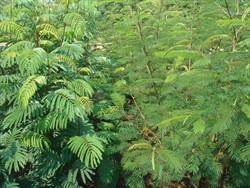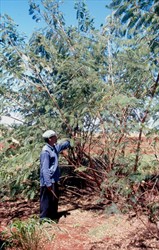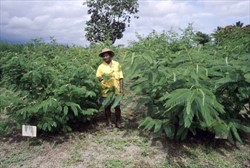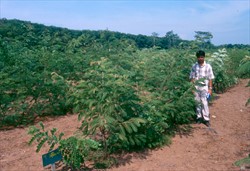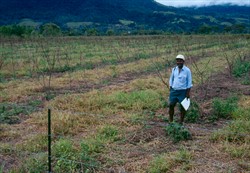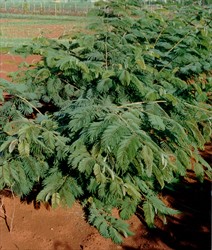Leucaena trichandra
Tropical Forages
Leucaena trichandra (Zucc.) Urb.
Basionym: Acacia trichandra Zucc.; Leucaena diversifolia (Schldl.) Benth. subsp. stenocarpa (Urban) Zárate; Leucaena stenocarpa Urban
Note: There has been some confusion over the years at the distinction between L. trichandra and L. diversifolia.
Family: Fabaceae (alt. Leguminosae) subfamily: Caesalpinioideae (mimosoid clade*) tribe: Mimoseae.
* Azani, N. et al. [97 authors from 54 institutions] 2017. A new subfamily classification of the Leguminosae based on a taxonomically comprehensive phylogeny. Taxon 66: 44–77.
Diverse species, small slender shrub 2 m tall to small to medium sized tree 5‒20 m tall with an open spreading crown. Leaves paribipinnate to 35 cm long with (5‒) 11‒22 (‒30) pairs of pinnae; petiole gland one, or rarely a pair of adjacent glands, unstalked, strongly and deeply crateriform, 1.6‒3.4 mm long by 1‒1.7 mm wide and 1‒2 mm tall, with an additional 1‒2 glands at the base of terminal and sub-terminal pairs of pinnae and, where many, at the base of all pairs of pinnae; pinnular rachis 4‒6 cm long, pinnules (20‒) 30‒40 (‒59) pairs/pinna, 4‒7 mm × 1‒2 mm, linear oblong, asymmetric at base, acute at apex. Capitulum (flower head) 7‒10 mm in diameter, 70‒130 flowers per head, heads in groups of 3‒5 in leaf axils, on actively growing indeterminate shoots; flowers variable in colour; stamen filaments and style white or tinged pink; nthers very hairy, pale cream, pinkish-grey to rose pink or occasionally pale violet; style white, tinged pink or scarlet. Pods 7‒11 cm × 13‒23 mm, 2‒4 per capitulum, narrowly or broadly linear-oblong, flat papery, yellow-green or reddish-green often deep maroon and very glossy unripe, becoming pale yellow or deep reddish-brown when ripe, sometimes lustrous, glabrous or covered in dense velvety hairs, opening along both sides. Seeds 3‒4 mm wide, 5‒7 mm long, aligned transversely in pods. 40,000‒70,000 seeds per kg.
Similar species
L. trichandra: 11‒22 pairs of pinnae/leaf; 30‒40 pairs of pinnules/pinna; length of pinnules 4‒ 7mm; width of pinnules 1‒2 mm.
L. diversifolia: 16‒24 pairs of pinnae/leaf; 48‒58 pairs of pinnules/pinna; length of pinnules 4‒5.5 mm; width of pinnules 0.8‒1 mm.
English: hairystamen leadtree
French: leucéna à étamines poilues
Latin America: shashil (Mexico, Tzeltal); guaje (Guatemala, Honduras, El Salvador and Mexico); guaje chiquito, guaje flojo, guaje rojo (Spanish)
Native:
Northern America: Mexico (Chiapas, Durango, Guerrero, Jalisco, Mexico, Morelos, Oaxaca, Puebla)
Central America: Belize; El Salvador; Guatemala; Honduras; Nicaragua
Forage
Has been extensively evaluated in agronomic and, to a lesser extent, in animal production trials. Used in hybridization programs with L. leucocephala in an attempt to produce an acid-soil tolerant hybrid.
Environment
L. trichandra has been used as a shade over coffee, generally in frost-free highland-tropical locations. Lopped leaves and twigs can be applied as green manure.
Other
In its native range, L. trichandra is used as a minor food crop, with the edible pods being eaten when more preferred species are unavailable. Trees are also commonly retained in cropping lands for multipurpose utilisation.
Soil requirements
Native to a wide range of soils from limestone-based vertisols to shallow, mildly acid-infertile alfisols and lithosols on volcanic ignimbrites and tuffs.
Moisture
Native range receives 1,000‒2,000 mm annual rainfall.
Temperature
Grows at 700‒2,000 m asl in frost-free climates with average annual temperatures from 17 to 22 ºC. Some accessions possess cool temperature adaptation for growth, although this is not strongly related to temperature in the native range. Most accessions are poorly adapted to high temperature environments.
Light
L. trichandra occurs primarily as a small understorey or lower canopy tree or shrub in pine and oak forests in parts of Central America and is therefore likely to be somewhat shade tolerant.
Reproductive development
Flowers June to September (mid-summer to early autumn) and fruits March to May (spring) in the native range. Pods mature in 80‒160 days.
Defoliation
Tolerance to regular cutting is accession and climate specific, with most high altitude accessions having a low tolerance when grown in hot, humid-tropical locations, but showing good tolerance to regular cutting at highland tropical locations.
Fire
Mature plants are tolerant of moderate intensity fires, regrowing readily from burnt stumps or branches.
Guidelines for establishment and management of sown forages.
Establishment
Essential to control competition with weed species. For best results plant on deep, well-drained soils with a pH above 5.5 and maintain a weed-free area of at least 2 m either side of the establishing plants. Seed must be scarified to break the impermeable testa. Previously, hot-water treatment was recommended but resulted in highly variable results including reduced viability. Mechanical scarification, using coarse sandpaper (for small seed lots) or abrasive lined rotating drum scarifiers, is now preferred. Specific rhizobium is required (e.g. CB 3060, TAL1145, LDK4).
Complete cultivation is recommended in extensive plantings. Planted into rows 4‒9 m apart at seeding rates of 2.5‒4.0 kg/ha. Herbicides such as bentazone (post-emergence) and imazethapyr (post-planting) can be used to control weeds during establishment. Alternatively, rolling cultivators can be used to control very young weed seedlings and break soils crusts after emergence of leucaena seedlings.
Small areas can be planted using either seed or seedlings. Seedlings are normally raised in poly bags for plug planting at 3‒4 months old. Seedlings can also be raised in beds and removed for planting as bare-rooted seedlings if 'topped and tailed'.
Fertilizer
Normally not fertilized under rain-grown conditions. Starter N and P may be used when establishing into depleted soils on cropping lands. Leucaena in Australia has occasionally responded strongly to added sulphur. On acid-infertile soils it is essential to add lime, P and K at planting and after each cut.
Compatibility (with other species)
Compatible with a range of grass species. Does not compete as well as L. leucocephala with companion grasses. Can be difficult to establish L. trichandra into existing grass pastures without clean cultivation.
Companion species
Grasses: L. trichandra has been grown experimentally with Urochloa decumbens in Papua New Guinea and wet tropical Australia and with Imperata cylindrica in the Philippines.
Normally grown as a hedgerow with grasses or crops grown between hedgerows.
Pests and diseases
A range of pathogenic fungi and insects occasionally attack L. trichandra. Newly emerged nursery and field-grown seedlings are susceptible to damping-off diseases caused by the fungal species, Pythium or Rhizoctonia. Elite accessions are resistant to psyllid insects, but L. trichandra is variable in psyllid resistance ranging from highly susceptible (OFI 4/91, OFI 140/92) to highly resistant (OFI 53/88). The soft scale (Coccus longulus) attacks the tall stems causing a reduction in productivity. The associated sooty mould that develops on the sugary exudates from the scale can cover the stems and temporarily kill under-storey grasses. Soft scale is generally an infrequent pest, with populations rarely building to cause economic damage. Soil insects such as earwigs, scarab beetles, termites and cut worms can cause serious damage to emerging seedlings and should be controlled. Seed production can be reduced by the flower-eating larvae of the moth Ithome lassula, and by four species of seed-eating bruchid beetles of the Acanthoscelides genus and Stator limbatus.
Ability to spread
Seedlings that may recruit will compete poorly with companion grasses and are susceptible to grazing. Is therefore most unlikely to spread under grazing.
Weed potential
Seed production varies greatly with provenance but can be very high. L. trichandra is therefore considered to have significant potential to colonise disturbed areas.
Nutritive value
A legume of low to moderate nutritive value due to the presence of low to high concentrations (1‒23% of DM) of highly astringent condensed tannins (CTs). Accession OFI 53/88 and CPI 46568 contained 18‒19% CTs, whereas OFI 138/92, an agronomically inferior accession, contained only 1% CT. The crude protein concentrations of 9 accessions ranged from 17 to 33%.
Palatability/acceptability
Moderate to high palatability under grazing by cattle and sheep in cafeteria trials in Australia and the Philippines. Less palatable than L. leucocephala but more palatable than L. pallida in grazing trials in the Philippines and Papua New Guinea.
Toxicity
Most accessions contain moderately high concentrations of astringent condensed tannins. Mimosine concentrations are similar to those of L. leucocephala (see L. leucocephala fact sheet).
Dry matter
Dry matter productivity is highly dependant on accession and environment. OFI 53/88 established rapidly in plot trials at humid locations in a multi-environment trial in Australia and southeast Asia, but subsequent growth was only moderate with the exception of highland-tropical environments, where the accession was comparatively highly productive. CPI 46568 was of moderate productivity, whereas OFI 4/91 was of very low productivity in most environments. Of 9 L. trichandra accessions evaluated in subtropical Australia and humid tropical Philippines, many accessions yielded very poorly, particularly in the Philippines. OFI 53/88 was the highest yielding accession at both sites, but its comparative advantage was much greater at the cooler Australian site.
Animal production
In the Philippines, L. trichandra OFI 53/88 was planted as hedgerows into Imperata cylindrica. Palatability was low to moderate in comparison with L. leucocephala, but the addition of L. trichandra did improve the forage quality of the grass pasture to some extent with L. trichandra and L. leucocephala pastures supporting liveweight gains of 0.40 and 0.43 kg/head/day, respectively, over a 6.5-month period. These liveweight gains were significantly higher than the 0.14 kg/head/day achieved from the I. cylindrica control.
In Papua New Guinea, L. trichandra CPI 46568 failed to improve liveweight gains of steers grazing Urochloa decumbens, with both the U. decumbens control and the L. trichandra - U. decumbens pastures supporting steer gains of 0.48 kg/head/day over an 8-month period.
L. trichandra is self-incompatible, with a chromosome number variously reported as 2n = 2x = 52, 54, 56; 2n = 4x = 104. However, some differentiate between L. trichandra and L. diversifolia on the basis of ploidy level, the former being diploid and the latter tetraploid. L. trichandra hybridizes well with the diploid species L. collinsii, L. shannonii, L. lanceolata, and L. multicapitula, but less well with tetraploid and other diploid species.
Small-scale seed-production orchards of L. trichandra have been successfully established by WAF (formerly ICRAF) in Kenya and CSIRO in Australia. No details regarding seed yields are available.
Herbicides such as bentazone (post-emergence) and imazethapyr (post-planting) can be used to control weeds during establishment.
L. trichandra can be killed by basal bark application of herbicides containing 120 g/L picloram and 240 g/L triclopyr mixed with diesel. Application of glyphosate to regrowth following slashing will kill trees, although repeat applications may be necessary.
- Adapted to highland-tropical environments.
- Resistant to the psyllid insect.
- Rapid establishment growth.
- Must select elite accessions only as the species is highly variable.
- Nutritive quality is considerably lower than for L. leucocephala.
- Poorly adapted to dry or hot humid environments.
Galgal, K.K., Shelton, H.M., Mullen, B.F. and Gutteridge, R.C. (2006) Animal production potential of some new Leucaena accessions in the Markham valley, Papua New Guinea. Tropical Grasslands 40:70–78. bit.ly/3dHYs99
Hughes, C.E. (1998) Leucaena, A genetic resources handbook. Oxford University Press, Oxford, UK. bit.ly/2Iw31af
Shelton, H.M., Gutteridge, R.C., Mullen, B.F. and Bray, R.A. (eds). (1998) Leucaena - adaptation, quality and farming systems. Proceedings of a Workshop Held in Hanoi, Vietnam, 9–14 February 1998. ACIAR Proceedings No. 86. Australian Centre for International Agricultural Research (ACIAR), Canberra, Australia. purl.umn.edu/135197
Note: Detailed updates on knowledge relating to Leucaena were provided in papers presented at the International Leucaena Conference held at The University of Queensland, Brisbane, Australia, 1‒3 November 2018. All papers were published under a publication agreement with the Organizing Committee in two Special Issues of Tropical Grasslands-Forrajes Tropicales: ILC2018 No. 1 - May 2019 Vol 7, No 2. 24 papers presented during Sessions 1‒4 of the Conference. http://www.tropicalgrasslands.info/index.php/tgft/issue/view/29/showToc and ILC2018 No. 2 - September 2019 Vol 7, No 4. 36 papers presented during Sessions 5‒8 of the Conference. http://www.tropicalgrasslands.info/index.php/tgft/issue/view/31/showToc.
No cultivars formally released
OFI 53/88 Kenya (1998) (not formally released). Well adapted to highland tropical locations. Establishes rapidly and has excellent psyllid tolerance. Seed produced by WAC (formerly ICRAF) in Kenya.
CPI 46568 Identified by CSIRO, Australia. Origin near El Trapichito, Guatemala (14.8º N, 810 m asl). High psyllid resistance and adaptation to low temperatures, but poor tolerance of dry conditions. Outyielded L. leucocephala cv. Cunningham under cool, humid conditions. Not released due to relatively poor liveweight gains of cattle in grazing trials. Currently held as L. diversifolia in a number of collections.
